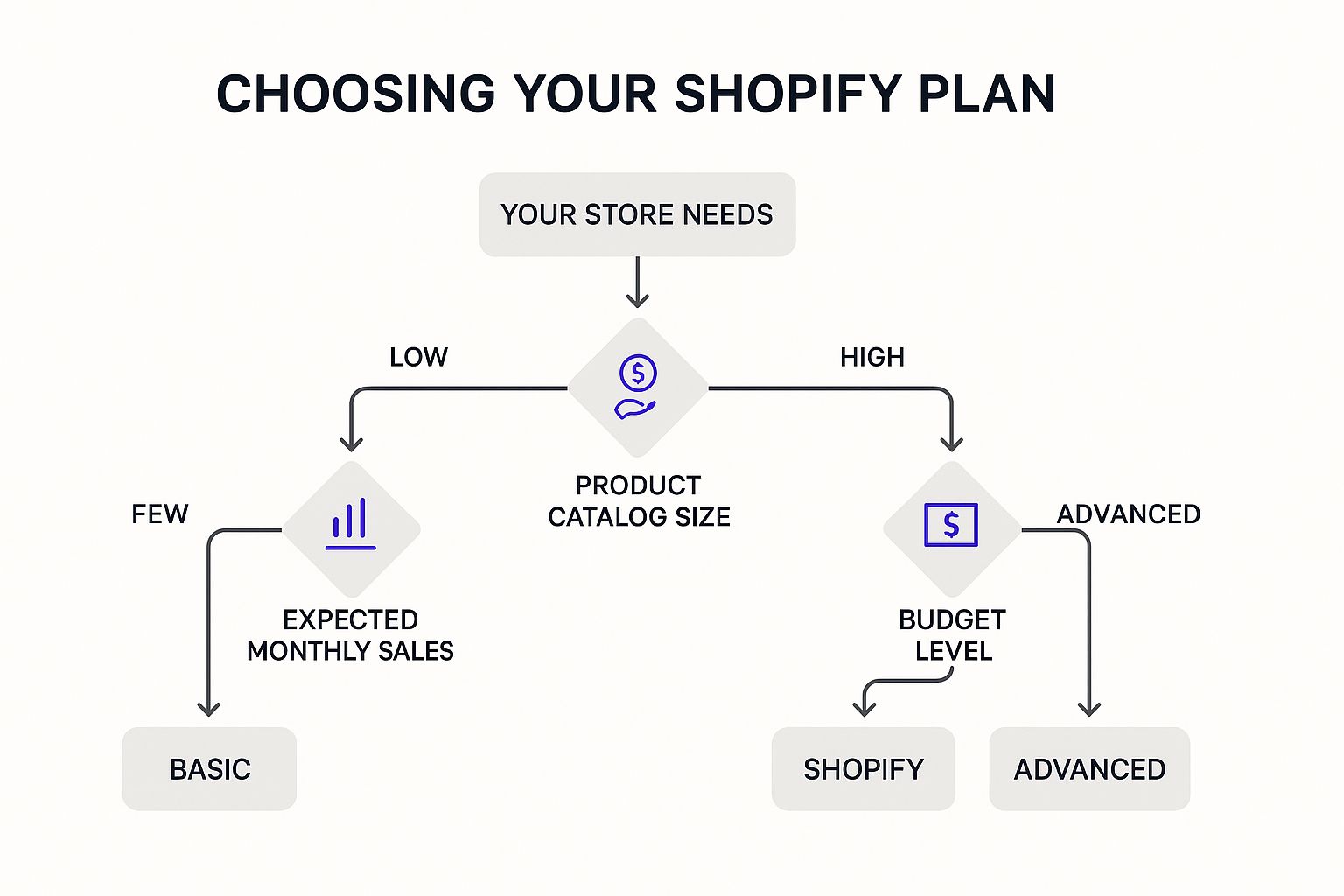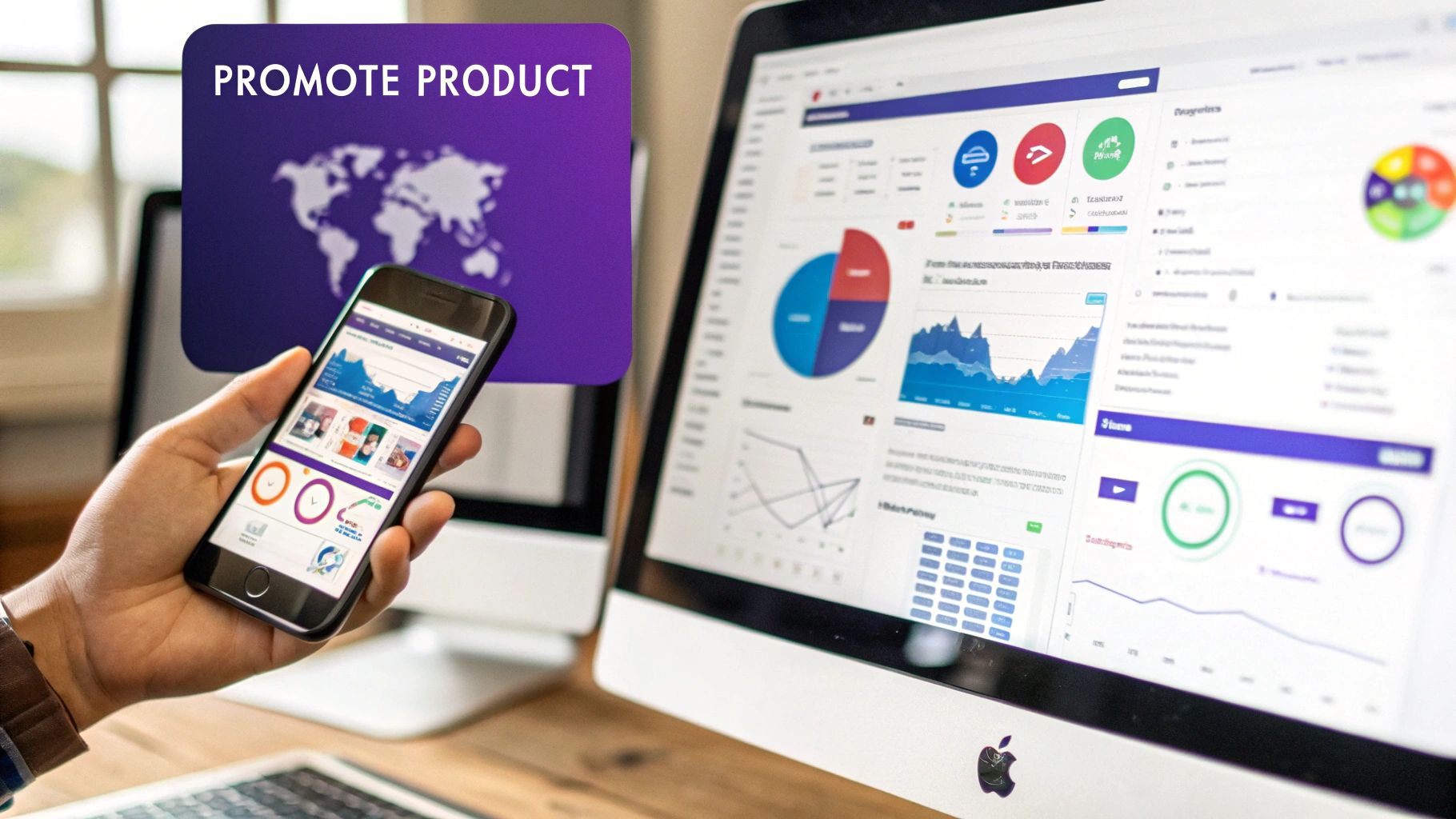Navigating the Digital Product Landscape on Shopify
The world of digital products offers exciting opportunities for Shopify sellers. From informative ebooks and online courses to practical tools like software and design templates, the options are diverse. Understanding current trends and finding profitable niches is essential for success.
Ebooks remain a popular choice for sharing valuable knowledge, while premium design assets are highly sought after by creative professionals. So, which digital products offer the best combination of profitability and low competition?
Finding Your Digital Product Niche
Identifying a profitable niche is the first step. This involves researching market demand, understanding your target audience's needs, and analyzing what competitors are offering. Keeping an eye on emerging trends will help you position your products for long-term success.
If you're an expert in a specific field, consider creating an online course or instructional videos. This is a great way to share your knowledge with a broader audience and generate income. This naturally leads us to explore Shopify's strengths as a platform for selling digital goods.
Why Choose Shopify for Digital Products?

Shopify offers several advantages for selling digital products. The user-friendly interface makes setting up and managing your online store simple. The platform’s expansive app ecosystem seamlessly integrates with various tools for digital product delivery, marketing, and customer support.
It’s important to consider the market context when selecting any platform. Shopify holds a significant 10% share of the global ecommerce market as of 2025. This strong market position is driven by its intuitive design and robust app ecosystem, crucial features for businesses selling digital products.
With millions of active stores and a considerable presence in key markets like the U.S., Australia, and Canada, Shopify offers a robust selling environment. In the United States, Shopify’s market share is especially impressive, reaching approximately 29% as of early 2025. This represents a substantial opportunity for businesses looking to sell digital products in these markets. For more detailed statistics, check out this report: Shopify Statistics 2025.
Leveraging Shopify's Ecosystem
Success on Shopify means using its powerful features to their full potential. From integrated marketing tools to robust analytics, Shopify provides the resources you need to connect with your target audience and optimize your sales strategies.
This includes utilizing apps designed for digital product delivery and management, such as automated email sequences and secure file hosting. By understanding how these tools work together, you can create a smooth and efficient sales process. Ultimately, navigating the digital product landscape on Shopify requires a strategic approach to niche selection, platform utilization, and ongoing optimization.
Building Your Digital Product Shopify Store That Converts
Creating a successful Shopify store for digital products involves more than just uploading files and pricing. It demands a strategic approach to store design, product presentation, and automated delivery that builds customer trust and boosts conversions. A vital first step is choosing the right Shopify plan.
The infographic below illustrates key factors to consider when selecting a plan: projected monthly sales, product catalog size, and your budget. This decision tree helps guide you towards the best fit, whether it's the Basic, Shopify, or Advanced plan.

As the infographic shows, businesses with high sales and large catalogs benefit from the Shopify or Advanced plans, while smaller stores with tighter budgets might find the Basic Shopify plan suitable. Selecting the right plan establishes a foundation for scalable and cost-effective operations. For more detailed information, check out this helpful resource: How to master selling digital products on Shopify.
To help you choose the right plan, let's look at a comparison of the different options:
To help you understand the different Shopify plans, here’s a handy comparison table:
Shopify Plan Comparison for Digital Product Sellers This table compares the different Shopify plans and their features specifically relevant to digital product sellers.
| Plan | Price | Digital Product Features | Transaction Fees | Best For |
|---|---|---|---|---|
| Basic Shopify | $25/month | File storage for digital products, unlimited bandwidth | 2% |
For solo entrepreneurs |
| Grow Shopify | $65/month | All Basic features, plus professional reports | 1% | Growing businesses with moderate sales volume |
| Advanced Shopify | $399/month | All Shopify features, plus advanced report builder and third-party calculated shipping rates | 0.6% | Established businesses with high sales volume |
This table provides a quick overview of the different plans. Remember to consider your specific needs and growth projections when making your final decision.
Designing for Trust and Conversion
Building trust is crucial when selling digital products. Start with a professional store design that clearly shows your brand and the value of your products. A clean layout, high-quality product images, and a clear value proposition significantly impact customer perception.
Incorporating trust badges, secure checkout processes, and customer testimonials can further enhance confidence. Investing in a well-designed store directly impacts your conversion rates.
Streamlining Product Pages for Digital Success
Effective product pages are essential for converting browsers into buyers. Because customers can't physically examine digital products, provide clear descriptions, compelling visuals, and address any potential concerns upfront.
Using mockups, previews, or video demonstrations showcases your product's functionality and benefits, helping customers visualize how it will solve their problems or improve their experience.
Automated Delivery: The Key to a Seamless Experience
Automated delivery systems are crucial for customer satisfaction and operational efficiency. This ensures instant access to purchased products and saves you time and resources.
Instead of manually emailing download links, an automated system instantly delivers them upon purchase, creating a seamless and positive customer experience.
Configuring Taxes for Digital Goods
Digital products have unique tax implications. Shopify lets you configure tax settings specifically for digital products, ensuring compliance with various regulations based on location. Understanding and correctly configuring these settings prevents potential legal issues and customer confusion. By addressing these key aspects, you can significantly improve conversion rates and build a thriving digital product business.
Creating Digital Products That People Actually Buy

Creating a digital product and listing it on Shopify isn't enough to guarantee success. Many digital products fail because of insufficient planning and poor positioning. This means you need to understand what makes a digital product attractive and how to present it to the right audience.
Understanding the Value Proposition
Before you start creating, ask yourself: what problem does my product solve? An ebook, for example, could offer valuable insights, while a template could save buyers time and effort. This problem-solving focus is the core of your value proposition.
Knowing your target audience is also crucial. Are you selling to beginners or seasoned professionals? This will influence your product's content, format, and even price. Understanding your audience helps you create something they truly value.
Formatting for Maximum Impact
Different digital products need different formatting. For online courses, structure the content into modules with clear learning objectives. For templates, ensure they are easily customizable for various situations. This thoughtful formatting maximizes the perceived value.
A well-structured online course hosted on your Shopify store, powered by a platform like Tevello, could provide a seamless learning experience directly linked to product purchases. This enhances the overall customer experience.
Overcoming the Intangibility Problem
Digital products are intangible, making them harder for potential buyers to understand. This makes showcasing their value visually even more important. Compelling mockups and previews can bridge this gap.
Think of a mockup as a "digital package." It visually represents what the buyer receives and how it benefits them. This makes the intangible feel more concrete, similar to attractive packaging for a physical product.
Digital products, created once and sold repeatedly, are a lucrative opportunity for Shopify businesses. Popular options include ebooks, online courses, and software. Shopify's app ecosystem offers tools to manage, promote, and deliver these products efficiently.
In Shopify-dominant markets like the U.S. and Canada, businesses can reach a large customer base. Shopify powers over 5.23 million active online stores globally, a vast network for selling digital products. Shopify's financial performance, such as achieving $2.16 billion in Q3 of 2024, reinforces its potential for digital product commerce. Learn more: Digital Products on Shopify.
Pricing and Bundling Strategies
Pricing psychology significantly influences customer perception. Tiered pricing can cater to different budgets and needs. Bundling related products is another effective strategy, boosting average order value without extra creation effort.
For example, offer a basic template at a lower price, a premium template with more features at a higher price, and a bundle of both with a discount. This gives customers choices and can increase revenue. Strategic positioning transforms digital products from simple files into valuable solutions that customers want to buy.
The Digital Delivery Toolkit: Apps That Do the Heavy Lifting
Selling digital products on Shopify is more than just having great content. You also need a solid delivery system. With so many apps available, choosing the right ones can feel overwhelming. This section helps you cut through the noise and find the apps that truly add value.
Essential Apps for Seamless Delivery
A smooth digital product experience on Shopify relies on a few key app categories:
-
Delivery and Access: These apps automate getting your digital products to customers right after purchase. This ensures instant access and makes a great first impression.
-
Intellectual Property Protection: Protecting your digital creations is crucial. Look for apps with features like PDF stamping, download limits, and license keys to safeguard your work.
-
Analytics and Reporting: Knowing how customers interact with your products is key for improvement. Analytics apps provide data on downloads, access, and customer behavior.
Choosing the right apps from these categories builds a foundation for efficient delivery, tight security, and data-driven improvements.
Comparing Top Digital Product Apps
To make informed choices, let's compare some of the best Shopify apps for digital product sellers:
To help you choose, here's a comparison of popular apps:
| App Name | Core Features | Price | Rating | Best For | Limitations | ||
|---|---|---|---|---|---|---|---|
| Tevello |
|
$29/month | 4.9/5 | Shopify merchants selling courses, memberships, or bundled physical and digital products |
Integrates deeply with Shopify, but limited support for external platforms |
||
| Easy Digital Products (EDP) | Secure file delivery, license keys, order management | Varies based on plan | 4.7/5 | Selling a variety of digital products, including software, ebooks, and courses | Can be pricey for basic needs | ||
| SendOwl | Subscription management, automated emails, affiliate marketing tools | Varies based on plan | 4.5/5 | Businesses focused on subscriptions or memberships and needing robust marketing | Steeper learning curve | ||
| Sky Pilot | Membership site creation, content dripping, community features | Varies based on plan | 4.8/5 | Creating exclusive membership areas with gated content and community engagement | Might be overkill for simple product sales | ||
| Deliverful | Automated delivery, file hosting, customer notifications | Free plan available, paid plans for more features | 4.0/5 | Beginners or those with simple delivery needs | Limited features |
This table is a starting point. The "Best For" and "Limitations" columns highlight strengths and weaknesses to help you find the best fit. Consider your product complexity, marketing strategy, and budget. Integrating a platform like Tevello directly into your Shopify store adds another layer of functionality, especially for courses and community building, streamlining the customer experience.
Avoiding Compatibility Issues
While apps enhance your store, compatibility problems can create a frustrating customer experience. For instance, a delivery app might clash with your theme, or an analytics app might not integrate with your marketing tools. Thoroughly test your chosen apps before launching them to your customers.
Also, prioritize apps with excellent customer support. A responsive team helps resolve technical problems quickly, minimizing disruptions. For example, prompt support for a delivery problem can save you time and prevent customer frustration.
Building a Streamlined Tech Stack
Creating an efficient digital product delivery system is more than just picking apps; it's building a seamless tech stack. Consider how each app interacts with the others and prioritize compatibility. By understanding potential problems and focusing on integration, you can build a system that grows with your business, provides a great customer experience, and avoids wasted costs.
Marketing Digital Products That Sell Themselves

Generic marketing advice simply isn't enough in the competitive world of digital products. Successful sellers know that promoting digital goods requires a different approach, one that emphasizes value and provides instant gratification. Let's delve into how successful stores are achieving consistent conversions.
Crafting Irresistible Lead Magnets
A lead magnet is a crucial part of any successful digital product strategy on Shopify. This is a valuable piece of content offered free in exchange for a customer's email address. Think mini-ebooks, checklists, templates, or access to a webinar – anything that provides real value to your target audience.
For example, if you sell online photography courses, a lead magnet could be a free checklist titled "10 Essential Settings for Stunning Photos." This immediately establishes you as an expert and offers something practical for your audience. It paves the way for nurturing leads towards your premium products.
Email Sequences That Convert
Once you've captured leads, a well-crafted email sequence is essential for turning them into paying customers. These aren't just ordinary promotional emails. They offer valuable content, build trust, and subtly guide prospects towards your paid products.
Consider this example sequence:
- Email 1: Welcome and delivery of the lead magnet.
- Email 2: A helpful tip related to the lead magnet's topic.
- Email 3: A case study demonstrating how your product helped someone.
- Email 4: A limited-time special offer.
- Email 5: A reminder of the offer and its key benefits.
This strategic approach nurtures leads, educates them about your product’s value, and motivates them to purchase. For more insights, check out this resource: Boosting your digital product launch.
Rethinking Social Proof for Digital Products
Standard social proof, like general reviews, isn't always effective for digital products. Smart sellers understand the power of specific testimonials that directly address buyer concerns. Instead of simply "Great product!", encourage customers to share how your product solved a problem or improved their workflow.
For instance, a testimonial for a design template could be: "This template saved me hours of work and helped me create professional graphics even without design experience." This resonates more effectively with potential buyers facing similar challenges.
Leveraging Shopify and External Channels
Promoting digital products requires a multi-faceted strategy. Utilize Shopify’s built-in tools, like email marketing and discounts, but also explore external channels. Think social media advertising and influencer partnerships to broaden your reach.
Imagine casting a wide net. Using multiple platforms increases your chances of reaching the right audience at the right time. This targeted visibility translates into sales. The global ecommerce market is projected to reach $4.8 trillion by 2025, presenting a vast opportunity for digital product sales. Learn more: Shopify Enterprise Blog. This growth underscores the increasing importance of Shopify’s tools and integrations for selling digital products.
By implementing these strategies, you can build a marketing engine that generates consistent sales, allowing you to focus on creating valuable digital products while your marketing works efficiently in the background.
Mastering the Digital Product Customer Experience
The customer experience is paramount for any digital product business. A seamless and enjoyable experience translates to positive reviews, repeat customers, and a flourishing business. On the flip side, a frustrating experience can quickly lead to abandoned purchases, refund requests, and negative word-of-mouth. Let's delve into building a positive customer experience that cultivates loyalty and boosts sales.
Designing Intuitive Navigation
Imagine a physical store with disorganized shelves and confusing signage. It's a frustrating experience. The same principle applies to your online store. Customers need to find what they're looking for quickly and efficiently. This means designing intuitive navigation that guides them effortlessly through your digital product catalog.
Use clear categories and subcategories, a powerful search function, and filters to help customers narrow down their choices. This simplifies browsing and increases the likelihood of purchases. Also, ensure your website is mobile-friendly, as many customers shop on their smartphones.
Creating Compelling Product Pages
Your product pages are your digital storefront. They should be more than just a list of features and prices. They should address the unique concerns of digital customers. Since customers can’t physically examine your product, provide ample information to build trust and overcome any hesitation.
Include high-quality product images, video demonstrations, and detailed descriptions that highlight the benefits and answer potential questions. Treat your product page like a salesperson, guiding the customer through the decision-making process.
Setting Clear Expectations
Managing customer expectations around delivery, access, and usage rights is crucial for digital products. Being upfront about these aspects prevents post-purchase confusion and frustration. Clearly explain the download process, usage limitations, and the terms of service.
For instance, if selling a design template, clearly outline the licensing agreement and permitted commercial uses. This transparency builds trust and avoids future misunderstandings. It also reduces support tickets related to usage questions.
Providing Excellent Support
Even with meticulous planning, customers will inevitably have questions or encounter issues. A robust support system is essential for addressing these promptly and effectively. This can include a comprehensive FAQ section, email support, and live chat for immediate assistance.
Consider creating self-service resources like video tutorials or knowledge base articles. These empower customers to solve problems independently, reducing support tickets and improving customer satisfaction by providing instant solutions. Keeping up with current trends is also essential for effective digital product marketing; explore various social media trend analysis tools. A key aspect of customer experience is a winning customer communication strategy. By focusing on these key areas, you can build a customer experience that differentiates you from competitors and transforms satisfied customers into loyal brand advocates. A positive customer experience is a long-term investment that pays off significantly. Integrating a platform like Tevello can greatly enhance the customer experience by offering seamless course integration and community-building features within your Shopify store.
Scaling Your Digital Product Empire on Shopify
Growing a single digital product into a flourishing collection requires a strategic approach. This means evaluating your current performance and identifying opportunities for expansion. Think about adding new products, enhancing existing ones, and implementing effective marketing strategies. This section explores how to transform your Shopify store into a scalable and profitable digital product powerhouse.
Analyzing Your Data for Growth Opportunities
Data is essential for making informed business decisions. Shopify provides valuable data on product performance, customer behavior, and sales trends. Analyzing this data can uncover hidden opportunities. You might discover a top-performing product ready for an upgrade or identify a market gap for a complementary offering. This allows for strategic refinement and maximizes your return on investment.
For example, if your ebook on beginner photography is performing well, consider developing an advanced course. You could also create a bundle of presets to cater to customers ready to take their skills to the next level.
Upselling and Cross-Selling: Maximizing Customer Lifetime Value
Upselling and cross-selling are effective techniques for increasing revenue from existing customers. For digital products, this could involve offering a premium version of a template. You might also bundle related products, or suggest an online course to complement an ebook. By presenting customers with relevant additional offerings, you can increase their lifetime value and boost your profit potential. This strategy is similar to how software companies offer different subscription tiers with varying features. Check out our guide on selling digital products on Shopify for more insights.
The Power of Subscription Models
Subscription models provide a predictable revenue stream and nurture ongoing customer relationships. Shifting from one-time purchases to subscriptions can significantly impact your bottom line. Consider offering a monthly membership for access to updated design templates. Alternatively, a yearly subscription for a premium content library could provide recurring revenue and build a loyal customer base. This predictable income allows for better business planning and sustainable growth.
Strategic Partnerships and Automation: Scaling Without Overwhelm
Strategic partnerships can significantly expand your reach without a proportional increase in effort. Collaborating with complementary businesses or influencers introduces your products to a new audience. This allows you to tap into existing communities and leverage the credibility of established brands. Automating key processes, such as email marketing and product delivery with tools like Klaviyo, frees up your time to focus on strategic initiatives. Automation is essential for efficient scaling. Think of it as building a system that works for you, even while you're not working. Crafting a solid customer communication strategy is crucial for a positive customer experience.
Building Your Digital Product Ecosystem
Scaling a digital product business on Shopify involves creating a cohesive ecosystem. Your products should complement each other and address evolving customer needs. This interconnected approach, from introductory lead magnets to premium subscriptions, maximizes customer lifetime value and fuels sustainable growth.
Ready to streamline your Shopify store with integrated courses and communities? Check out Tevello today! Learn more about Tevello and how it can transform your Shopify business.




